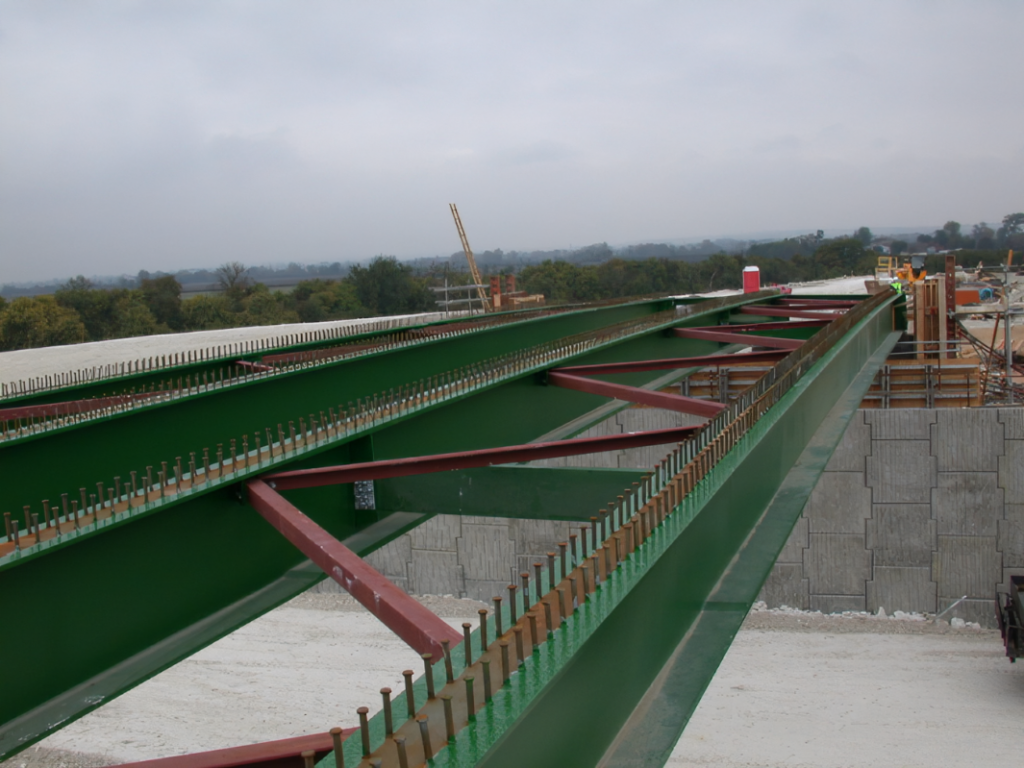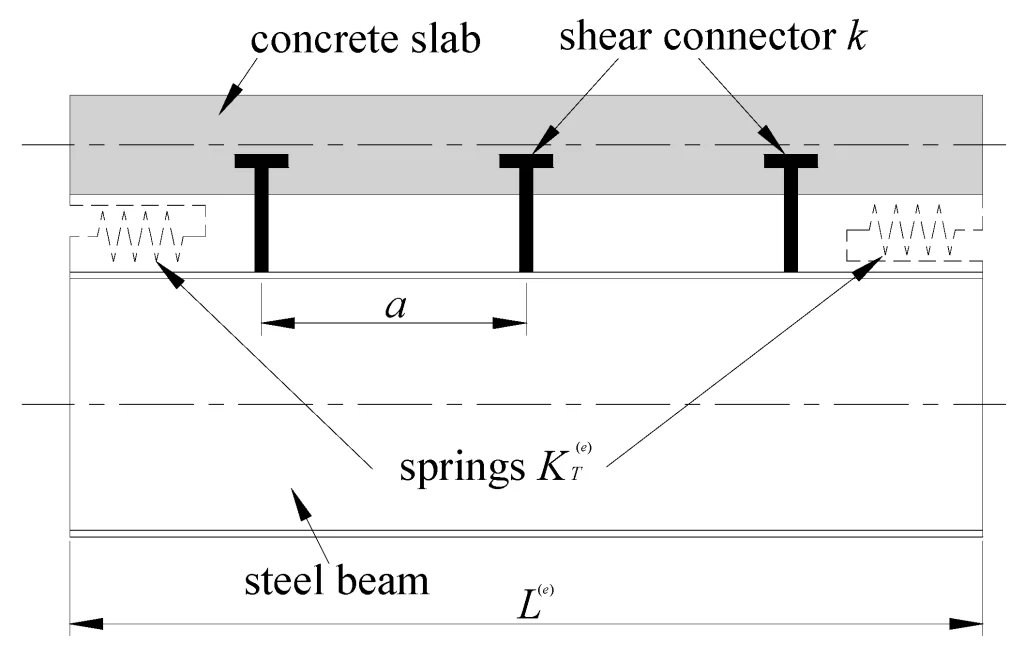This article offers guidance and recommendations on the design of shear connections for composite beams to Eurocode 4

Composite steel construction is integral to modern construction. It is a form of construction that combines the strengths of steel and concrete to optimize structural performance. A crucial element in their design, however, is the ‘shear connection’ (Figure 1). In composite beam design, a shear connection is that element which facilitates the efficient transfer of shear forces between the concrete slab and the steel beam. This connection not only enhances the composite action but also significantly improves the overall strength and stiffness of the structure.

As with the design of composite slab, beam and column which has been extensively covered in previous articles, the design of shear connectors is meticulously guided by Eurocode 4. In this article, we focus specifically on the design of shear connection in composite beams. For more general information on composite construction, visit www.steelconstruction.info.
Shear Connection in Composite Beams
Shear connections in composite beams are primarily achieved using headed stud connectors, which are actively welded to the steel beam and firmly embedded in the concrete slab. These connectors play a pivotal role in creating composite action between the steel and concrete, allowing the two materials to function as a single, unified unit. This integration is not just a technical necessity; it’s a game-changer that significantly boosts the structural integrity and performance of composite beams.
This synergistic action markedly enhances the overall stiffness and strength of the beam. As a result, composite beams can carry larger loads and span greater distances than their non-composite counterparts. By leveraging the unique properties of both steel and concrete through effective shear connection, these beams offer superior performance, making them indispensable in modern construction projects that demand both strength and efficiency.
Types of Shear Connectors
EC4 recognizes various types of shear connectors, each tailored to different applications and structural requirements.
Stud Connectors
Stud connectors are the most widely used shear connectors due to their simplicity and effectiveness. They are welded to the steel flange and embedded in concrete, providing robust shear resistance. The installation process is straightforward, making them a popular choice in many construction projects.
Channel Connectors
Channel connectors are embedded in the concrete and provide shear resistance through friction and interlock. They are often used in applications where high shear forces are anticipated. These connectors excel in scenarios where robust shear resistance is critical, such as in heavily loaded structures.
Perfobond Rib Connectors:
Perfobond rib connectors utilize perforated steel plates embedded in concrete. The holes in the plates allow the concrete to interlock with the steel, offering excellent shear resistance. This innovative design maximizes the interlocking effect, ensuring superior performance under high shear loads.
Key Parameters in Shear Connection Design
Designing shear connections to EC4 entails not only theoretical calculations but also practical considerations related to construction and performance. Some key practical aspects include
Shear Connector Type and Dimensions
The choice and size of shear connectors significantly influence the performance of the composite beam. Eurocode 4 specifies the use of headed stud connectors, detailing their dimensions and placement to ensure effective load transfer.
Material Properties
The mechanical properties of the concrete and steel, including their strengths and elastic moduli, are crucial in determining the number and arrangement of shear connectors. Higher strength materials can reduce the required number of connectors, optimizing the design.
Load Considerations
The design must account for various types of loads, including dead loads, live loads, and dynamic loads. The magnitude and distribution of these loads affect the shear forces that the connectors must resist.
Connector Spacing and Distribution
Proper spacing of shear connectors is essential to prevent local failures and ensure uniform load distribution. Eurocode 4 provides guidelines for the maximum and minimum spacing between connectors, as well as their placement along the length of the beam.
Design Methodologies
EC4 offers a detailed framework for shear connection design, incorporating both ultimate limit state (ULS) and serviceability limit state (SLS) considerations. The design process encompasses several key steps:
Determination of Shear Forces
The shear forces acting on the connection must be accurately calculated based on the overall structural analysis. This involves considering permanent loads, variable loads, and dynamic effects. Precision in this step is crucial for the integrity of the design.
Selection of Shear Connectors
Based on the calculated shear forces and specific structural requirements, an appropriate type and size of shear connector are selected. EC4 provides detailed guidance on the capacities and characteristics of different connectors. Choosing the right connector is essential for ensuring the effectiveness of the shear transfer.
Calculation of Connector Spacing
The spacing of shear connectors is a critical design aspect. EC4 specifies maximum and minimum spacing requirements to ensure adequate shear transfer while avoiding over-concentration of connectors. Proper spacing guarantees a uniform distribution of shear forces.
Verification of Connection Strength
The design strength of the shear connection must be verified against the applied forces. This involves checking both the shear capacity of the connectors and the interaction between steel and concrete components. Rigorous verification ensures the reliability of the connection.
Consideration of Fatigue
For structures subject to cyclic loading, the fatigue strength of the shear connectors must be assessed. EC4 provides specific guidelines for designing for fatigue effects. Accounting for fatigue is vital for the long-term durability of the structure.
Worked Example: Design of Shear Connectors for a Composite Beam
Problem Statement: Design the shear connection for a simply supported composite beam with a span of 6 meters. The beam supports a uniformly distributed load of 40 kN/m, including its self-weight. The steel beam is an IPE 400 section, and the concrete slab is 150 mm thick with a width of 2.5 meters. The concrete grade is C30/37, and the steel grade is S355.
Step 1: Calculate the Plastic Moment of Resistance (Mpl,Rd)
The plastic moment of resistance of the composite section is calculated by summing the contributions of the steel section and the concrete slab.
For the steel beam:
M_{pl,a}=f_y.W_{pl}Where: fy = yield strength of steel = 355 Wpl= plastic section modulus of the IPE 400 section = 920 cm
M_{pl.a}=355\times920\times10^{-6}=326.6kN.mFor the concrete slab:
M_{pl,c}=0.85f_{ck}A_czWhere: fck = characteristic compressive strength of concrete = 30; Ac = effective area of concrete in compression; z = lever arm between the centroid of the steel section and the centroid of the concrete slab
Considering the concrete width to be effective width:
b_{eff}=2.5mEffective area of concrete in compression:
A_c=b_{eff}.t =2.5\times0.15=0.375m^2Assuming the lever arm z is approximately 0.8 times the total depth of the section, we have:
z \approx 0.8\times(0.4+0.15)=0.44m
M_{pl,c}=0.85\times30\times0.375\times0.44\\=4.2kN.mTherefore, the total plastic moment resistance of the composite section is given as:
M_{pl,Rd}=M_{pl,a}+M_{pl,c}\\=326.6+4.2=330.8kN.mStep 2: Determine the Shear Force in the Connectors (V)
The total shear force to be resisted by the connectors is:
V=\frac{M_{pl,Rd}}{L}Where: L is the span of the beam.
V=\frac{330.8}{6}=55.13kNStep 3: Calculate the Number of Shear Connectors (N)
Using headed stud connectors with a nominal diameter of 19 mm and a height of 100 mm, the shear resistance of one connector PRd is given by:
P_{Rd}=0.8\times\frac{\pi}{4}\times d^2 \times f_{u}Where: d = diameter of the stud = 19 mm; fu= ultimate strength of steel = 450 MPa
P_{Rd}=0.8\times \frac{\pi}{4} \times0.0019^2\times450=9.9kNHaving determined the resistance of a 19mm stud, we can determine the number of required studs as:
N=\frac{V}{P_{Rd}}=\frac{55.13}{9.9}\approx 5.56Rounding up, we need 6 connectors.
Step 4: Verify Spacing and Distribution of Connectors
Eurocode 4 specifies the minimum spacing between connectors to prevent local concrete crushing and ensure effective load transfer. The minimum longitudinal spacing smin given by:
s_{min}=5d=5\times19=95mmThe maximum spacing smax is:
s_{max}=600mmSince the beam span is 10 meters, the connectors need to be distributed along this length. For simplicity, we can place the connectors evenly:
s =\frac{L}{4} =\frac{6000}{6} =1000mmThe spacing is outside the acceptable range specified by Eurocode 4, therefore we can include the stud’s number to 12 numbers
s = \frac{6000}{12} = 500mmThus, the spacing is now within the acceptable range specified by Eurocode 4.
Step 5: Check Connector Resistance to Combined Shear and Tension
The connectors must also be checked for resistance to combined shear and tension, especially if the beam is subjected to significant bending. The interaction between shear and tension forces is given by:
(\frac{V_{Ed}}{V_{Rd}})^2 + (\frac{N_{Ed}}{N_{Rd}})^2 \le1For simplicity, we assume negligible tension in this example, focusing solely on shear which forms a majority of the scenario encountered in practice.
Conclusion
The design of shear connectors in composite beams is a critical aspect of ensuring structural integrity and performance. By following the guidelines of Eurocode 4, we can achieve a reliable and efficient design that maximizes the benefits of composite construction. The worked example above illustrates the step-by-step process, from calculating the plastic moment of resistance to determining the number and spacing of shear connectors.
See: Designing a Composite Steel Column | Worked Example to Eurocode 4
Sources & Citations
- Institution of Structural Engineers (2010) Manual for the Design of Structural Steelwork to Eurocode 3
- Johnson R.P. and Anderson D. (2004) Designers’ Guide to EN 1994-1-1 Eurocode 4: Design of composite steel and concrete structures Part 1.1: General rules and rules for buildings, London: Thomas Telford